Industrial sewing machines are more than just equipment for commercial garment manufacturers – they’re the backbone of the entire operation. These high-powered machines handle the majority of garment production, from combining the fabric and supporting key sections of the apparel to adding details and accents that will enhance the final clothing.
Time to look into the various sewing machines available for your garment manufacturing business and see which ones will match your production requirements. We will also discuss some factors to consider when shopping for industrial sewing machines to ensure your investment is maximized.
Sewing Machine Types and Their Uses, Sorted by Function
Let’s begin our journey by exploring the various functionalities of industrial sewing machines. Based on your production demands, one or more of these industrial sewing machines will fit perfectly in your workshops.
Industrial Lockstitch Sewing Machine / Single Needle Sewing Machine
A staple in every garment construction facility, industrial lockstitch sewing machines or single needle sewing machines handle basic sewing of different woven fabrics. The main strength of this machine lies in its high versatility, allowing manufacturers to create a wide range of garment options for their clientele.
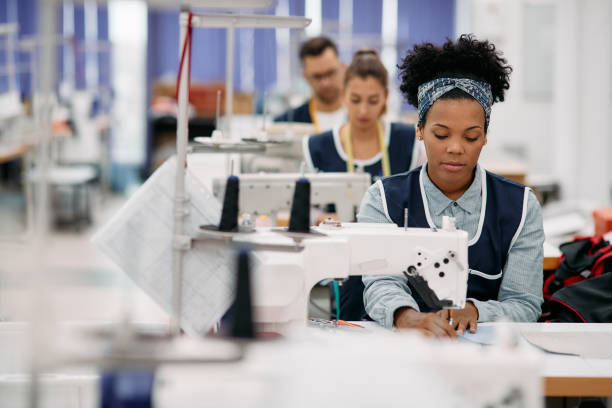
Core Mechanism:
The machine’s core mechanism includes four parts: the needle, the hook, the take-up lever, and the feed systems.
A single sewing needle is driven into the fabric with every rotation of the shaft, forming the thread loop. The thread is held on a bobbin hooked by a rotating shuttle, working in sync with the needle with every movement and complemented by the take-up levers. This produces the classic Type 301 lockstitch single needle sewing machines are known for.
Fabric is fed to the machine using a feed dog or a combination feed dog system, coordinating with the other mechanisms to move the fabric at a steady pace. The feed dog is complemented by the presser foot, creating friction that facilitates the fabric movement. This ensures smooth delivery of woven fabrics with minimal jamming or errors.
Stitching Result:
Thanks to the ingenious coordination of the various mechanisms of the industrial lockstitch sewing machine, it produces a tight, secure, and non-stretchy stitch. And despite being the most common stitch worldwide, this basic sewing machine offers a clean and reliable finish that has the same look on both sides of the garment.
Applications:
Due to the simple yet reliable stitching that the machine produces, it is widely used for making different garments. The machine is ideal for seaming, topstitching, and installing zippers on woven fabrics, as it creates a clean stitch.
Typical applications of industrial lockstitch sewing machines include swing side seams on most shirts and inseams on trousers. It is also the go-to machine in dressmaking, as it can produce large volumes of dresses within a short time span.
Sergers & Overlock Sewing Machines
Considered an advanced machine for sewing garments, overlock sewing machines come with specialized features to produce seamlessly sewn garments. More commonly called “sergers” in North America, these machines can trim, stitch, and finish seams in a single pass.
Core Mechanism:
A serger uses multiple threads to produce the stitches that loop around the fabric’s edge, ranging from one to four threads. Loopers work alongside the needles, forming the overlock stitch with each movement. The built-in knife on the machine trims excess fabric during the sewing process, leaving a clean edge.
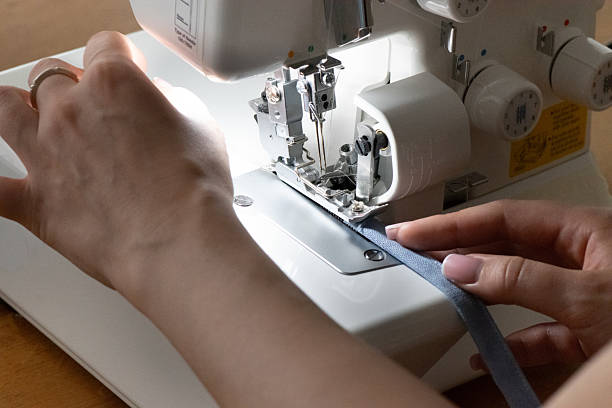
Stitching Result:
As the overlock sewing machine performs multiple tasks in a single pass, it can create a flexible and durable seam that prevents the fabric from fraying. The completed garment can freely move and stretch with ease, making it more comfortable and more functional for the wearers.
Applications:
Overlock sewing machines or sergers are the go-to machines for handling knit fabric and other stretchable fabrics. From denim pants and t-shirt production to jerseys and activewear, clothing manufacturers can rely on sergers to create professional-looking seams for their garments.
Key Stitch Types Available:
3-Thread Overlock – one of the most versatile stitches, it uses one needle to create the single stitch line. This type is usually used for finishing edges, seaming on t-shirt production and jerseys, and decorative stitching.
4-Thread Overlock – a stronger and more durable stitching option, this uses two needles and looper threads to create two rows of stitches. The safety stitch it adds to makes the garment extra strong and allows for free movement without the risk of damage. Ideally utilized in denim jeans and activewear.
5-Thread Safety Stitch – this combines 3-thread overlock with 2-thread chain stitch, adding strength and durability to the final garment. Commonly seen in most commercial garments, like pants, to prevent fraying and to finish edges.
Coverstitch Sewing Machine
The coverstitch sewing machine is a specialized machine with the dedicated purpose of hemming knits seen in various sportswear production and commercial garments. The parallel stitch lines it produces and the covered stitch on the underside make the garments more durable while enhancing stretchability, ensuring they are comfortable to wear.
Core Mechanism:
A conventional coverstitch sewing machine utilizes two to four needles to create parallel lines on one side of the fabric. This is then closed on the other side with an overlock stitch, resulting in a neat-looking, decorative stitch that doubles as added security to the garment.
What sets the coverstitch sewing machine apart is the inclusion of a dedicated looper mechanism to produce a strong and flexible seam that enhances the durability of the final garment. And unlike the serger, it doesn’t have a blade built into the machine for trimming edges.
Moreover, most coverstitch sewing machines utilize differential feeds, allowing operators to control the feeding of the material to the machine. This reduces the risk of overstretching the material while sewing, enhancing the overall appearance of the completed garment.
Stitching Result:
Hems produced by coverstitch sewing machines have a professional look that is not only comfortable to wear but also has excellent stretch recovery. The bottom side of the hem reveals a distinctive “double-track” or “ladder” pattern, adding detail to the apparel.
Applications:
Commercial garment manufacturers mainly use converstitch sewing machines for hemming t-shirt necklines, bottoms, and sleeves. They are also utilized to attach neckbands on garments, as well as decorative topstitching on most underwear and sportswear production.
Industrial Sewing Machine Types Sorted by Automation Level
Next, let’s look at industrial sewing machines based on their automation level. Sewing machines can be classified under basic, semi-automatic, and fully automatic options, each offering a set of features that will fit your manufacturing requirements.
The main difference among these swing machines lies in the level of operator involvement and the additional features that the equipment brings to the facility. The more advanced the sewing machine is and the more features it includes, the less involved operators are in the production process.
Basic Industrial Sewing Machines
Basic industrial sewing machines are designed to produce garments in a commercial workshop setup. As an entry-level equipment for commercial garment manufacturing, it has higher internal components and motors compared to machines used at home to handle industrial production needs. The design and construction of these machines are also finely tuned to endure long hours of operation without overheating or breaking.
Suitable for:
- Garments that require single, basic stitches, like a straight stitch, to complete
- Ideal for smaller workshops with low order volumes
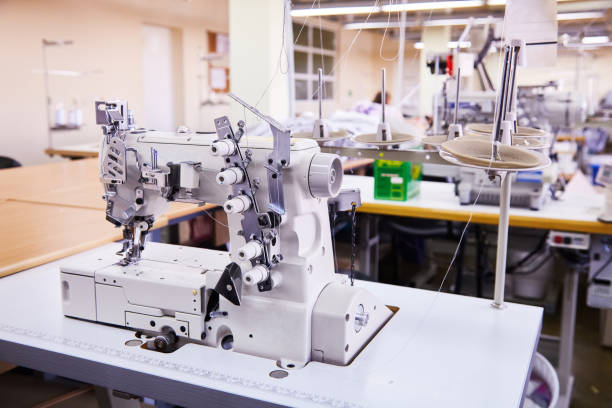
Pros:
- Low initial cost, as it has the least additional and automated features
- Simple to operate, requires a basic understanding of how sewing machines work
- Easy to maintain and troubleshoot, resulting in minimal downtimes and production delays
Cons:
- Lower overall productivity compared to other sewing machine types
- Little to no automated functions, typically only includes basic stitching capabilities
- Requires high operator involvement, from cutting the thread to feeding the material
Semi-Automatic Sewing Machines
Semi-automatic sewing machines bridge the line between basic and automatic sewing machines, enhancing the manual sewing capabilities with automated functionality. These typically include powerful motors to provide strong torque and piercing even at low speeds while creating smooth and consistent seams. Operator involvement is limited to guiding the fabric on the machine while it handles the various steps of the sewing process.
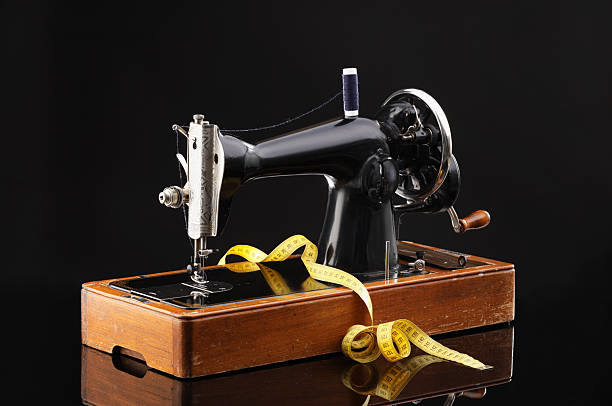
Suitable for:
- Facilities that handle high-volume production of commercial garments
- Workshops that are looking to automate some of their production steps, yet are working on a budget
Pros:
- Requires less operator involvement, typically only needed to start the process, and some manual configurations
- Includes automated functions to enhance garment production, like needle positioning and thread trimming
- Higher production output resulting from its automated features, making production more efficient
- Mid-range pricing gives facilities certain automation features without heavily investing in automated machines
- Can be used on a wide range of fabrics, offering versatility to the workshop
Cons:
- Still requires an operator for full functionality
- Single task specialization may limit production capabilities and may require facilities to purchase multiple types
- Needs operators to have an in-depth understanding to fully utilize the machine
- The inclusion of various electronics and computerized components may cause some downtime for repairs and maintenance
Fully Automatic Sewing Machines
Considered as high-end equipment for garment manufacturing facilities, fully automatic sewing machines are packed with automated features to streamline the production of commercial apparel. It offers high-volume production at a high financial investment.
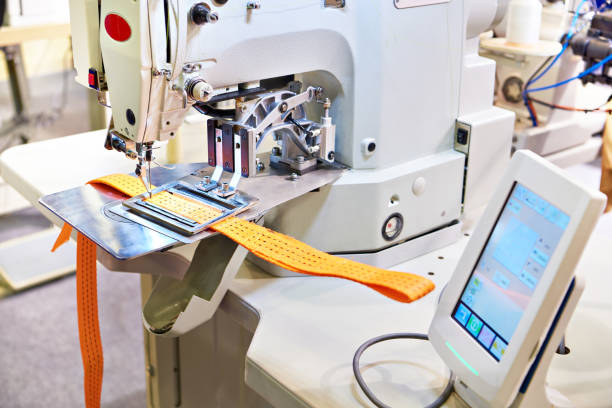
These specialized machines can handle sewing tasks with minimal intervention from operators, utilizing cutting-edge technology and computers to program the desired output. From sewing patterns and speed adjustment to handling specific tasks, these can be configured at the push of a button.
Aside from computerized controls, it is also designed to include high-powered components to endure long hours of operation while ensuring consistency. They can also be set up with automatic feeding and thread changing for faster and more reliable garment production.
Suitable for:
- Ideal for facilities that mass-produce garments with similar designs and patterns
- Facilities that offer multi-layer or heavy-duty apparel can benefit from automated sewing machines
Pros:
- Minimal operator involvement can reduce labor costs, as the machine handles the entire sewing process
- Automated features like programmable sewing patterns and automatic feeding improve production output
- Can handle complex processes with ease, with some models capable of integrating with CAD systems
- Makes customization and personalization of commercial garments more reliable and seamless
Cons:
- Heavy financial investment, as most automated sewing machines cost more due to added features
- Requires specialized training to operate the machine at optimal levels
- The complex systems and computerized features may require specialized personnel to maintain and troubleshoot the machine, leading to longer downtimes
Other Sewing Machine Types for Commercial Use
Commercial garment manufacturing involves several steps to turn pieces of fabric into stunning and functional clothing. Here are other industrial sewing machines with specialized functions that will complete your garment production lines.
Buttonhole Machine
First, we have buttonhole machines, which are specifically designed to fasten or sew buttonholes on garments. These machines feature various mechanisms to ensure consistent production of buttonholes on each garment with exceptional accuracy. Some buttonhole machines even utilize modern technology for easy programming that can be modified based on production needs.
Buttonhole machines come in two main types, namely:
Flat Bed Buttonholer – typically used to add standard buttonholes on shirts, blouses, and other commercial garments.
Bartack Buttonholer / Keyhole Buttonholer – often used to create reinforced, round-ended buttonholes that will stay in shape over time. Ideal when working with heavy fabrics and thick garments like suits and coats.
Button Sewer
Another specialized sewing machine in commercial garment manufacturing, button sewers are built to attach buttons automatically to different types of clothing. Using a single needle and thread, this machine sews 2-hole or 4-hole buttons to the garment with a cross or parallel stitch pattern. The consistent tension and speed the machine produces to secure the buttons greatly exceeds the results offered by manual sewing methods, making it great for large-volume manufacturing.

To improve its functionality, some button sewers have an automatic button feeder that helps streamline the process. Modern models also come with programmable settings that automatically adjust stitch length and other configurations depending on production requirements.
Seamless Sewing Machine
For commercial garment manufacturers that aim to produce apparel with greater comfort and durability, they can opt for industrial seamless sewing machines. This specialized sewing machine doesn’t use traditional stitched seams in creating the garments, resulting in flat, strong, and smooth seams.
Two main types of seamless sewing machines:
Seamless knitting machines – knit fabrics in a circular pattern to create the garment in a single piece with no seams.
Seamless bonding machines – also referred to as seamless stitching machines, use alternative methods to combine different fabrics to create flat and strong seams. The methods it implements include high-frequency vibrations, heat, special adhesives, and blindstitching, to name a few.
Applications:
Seamless sewing machines see great use in manufacturing garments where traditional seams can cause discomfort, like in activewear, sportswear, intimate apparel, and medical clothing.
Bartacking Sewing Machine
Bar-tracking sewing machines specialize in producing dense, reinforced stitches that strengthen key stress points in garments. The machine creates closely spaced stitches in a zigzag pattern, also called “bartacks”, which spreads the pressure on the fabric to reduce the stress on focal areas.
Most bar-tracking sewing machines come in manual and automatic options, each offering specific benefits for commercial garment manufacturers. Manual models are typically more affordable and are more ideal for small-scale productions. Automatic models, on the other hand, fit large-scale productions better as they are faster and more efficient, though they have a higher price tag.
Applications: Reinforcing pocket corners on denim jeans, belt loops, and the ends of zippers on workwear and bags.
Due to their reinforcing capabilities, bartracking sewing machines are used to support pocket corners on denim jackets, belt loops, and at zipper ends for bags. They can also be used to attach labels and patches, as well as to add decorative patterns on garments.
Blind Stitch Sewing Machine
If you’re looking to produce garments with discreet hems, then a blind stitch sewing machine is the right choice for the task. By catching a few threads from the main fabric, the machine creates a secure seam on the inside while being unnoticeable on the outside. Using a thread that has a similar shade to the fabric also helps with the invisible aesthetic, further improving the overall appeal of the completed garment.

Commercial garment manufacturers that focus on tailoring and formal wear will benefit from using blind stitch sewing machines. These machines can be used in hemming dress pants and suit trousers, giving the garments a smooth, clean finish while staying strong and durable.
How to Choose the Right Industrial Sewing Machine
Selecting an industrial sewing machine for your garment manufacturing business requires intensive research and preparation. As industrial sewing machines will be the backbone of the business and entail significant investment, it’s crucial to choose the ideal equipment for the job. To help you in the selection process, we’ve prepared three factors to consider based on our years of assisting clients.
Fabric & Product Type:
The first, and arguably the most important factor in selecting the right sewing machine, is the type of fabric your facility will be working with. Why do we emphasize the kind of fabric, you may ask? Remember that different sewing machines specialize in specific fabrics, and securing the right machine to handle your preferred material and desired stitch types will make the production process more efficient.
Knit fabrics used in creating t-shirts and activewear, for example, are soft and stretchable materials. And due to their flexible qualities, they can snag or run when using an incompatible sewing machine. For knit fabrics, it’s best to use overlock sewing machines, as the stitches they produce allow the fabric to maximize its stretchability without breaking.
On the other hand, woven fabrics for denim garments, formal wear, and jackets are more durable and easier to stitch. These fabrics have more resilience to wear and tear while staying stable, making it easy to sew. Industrial lockstitch sewing machines can handle woven fabrics well, as they don’t need specific mechanisms to produce the garments.
Production Volume & Budget:
Next, consider the projected production volume of your garment business before deciding on what kind of industrial sewing machine to purchase. Higher production volumes will demand more from your sewing machine, so make sure you procure one that can adapt to the environment.
The multiple features and efficiency of automatic sewing machines make them ideal for high-volume production, reducing manufacturing times while offering consistent output. Semi-automatic sewing machines, on the other hand, fit perfectly in smaller workshops where production volume requirements are lower and can take more time to fulfill orders.
At the same time, factor in your available budget in the selection process. Depending on the type of sewing machine and the features it includes, prices per machine may vary significantly.
Automated sewing machines require a heavy investment, though they can handle more volume and require less manual labor to complete projects. Conversely, semi-automatic sewing machines are relatively more affordable compared to automatic models, but would demand more attention from the operator.
Desired Finish:
Third on our list of points to consider is the type of finish you want your wholesale garments to have. Some industrial sewing machines can specialize in various stitching options, thus making them preferred choices in certain garment manufacturing facilities.
If you require professional hemming on your stretch garments, then you should secure coverstitch machines. The coverstitching adds clean and durable hems to the garments, enhancing their stretchability and overall functionality.
Additionally, there are industrial sewing machines that include a backtracker option to make garments more durable and secure. These machines are a must-have for facilities that manufacture durable workwear, as they improve the performance of the completed garments.
Stitching Things Up
Industrial sewing machines are an integral part of any commercial garment manufacturing facility, standing as the backbone of the production process. These machines sew fabrics using the latest innovations, creating diverse garments according to market demands.
Additionally, industrial sewing machines come in a range of options, each specializing in certain stitching capabilities that make garment production faster and more consistent. Knowing how to choose the right machine for your facility will help maximize your investment.
If you’re looking for a workout clothing manufacturer for your next project, choose to work with an industry expert like Uga Wear. We’ve been the leading clothing manufacturer for more than a decade, with numerous global brands trusting our quality and production expertise. Schedule a free consultation today and see how we can bring your next project to life.

